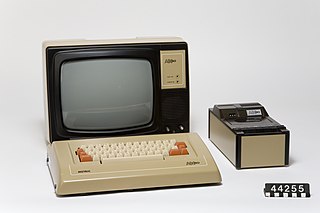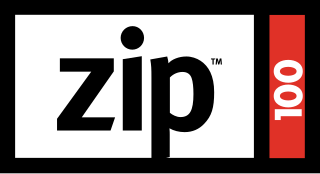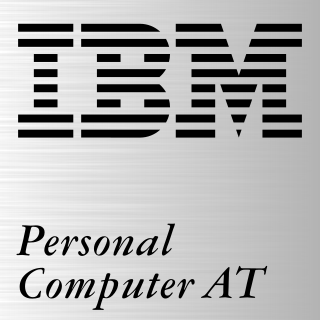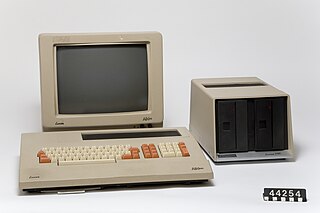
Parallel ATA (PATA), originally AT Attachment, also known as Integrated Drive Electronics (IDE), is a standard interface designed for IBM PC-compatible computers. It was first developed by Western Digital and Compaq in 1986 for compatible hard drives and CD or DVD drives. The connection is used for storage devices such as hard disk drives, floppy disk drives, optical disc drives, and tape drives in computers.

A floppy disk or floppy diskette is a type of disk storage composed of a thin and flexible disk of a magnetic storage medium in a square or nearly square plastic enclosure lined with a fabric that removes dust particles from the spinning disk. The three most popular floppy disks are the 8-inch, 5¼-inch, and 3½-inch floppy disks. Floppy disks store digital data which can be read and written when the disk is inserted into a floppy disk drive (FDD) connected to or inside a computer or other device.
DNIX is a discontinued Unix-like real-time operating system from the Swedish company Dataindustrier AB (DIAB). A version named ABCenix was developed for the ABC 1600 computer from Luxor. Daisy Systems also had a system named Daisy DNIX on some of their computer-aided design (CAD) workstations. It was unrelated to DIAB's product.
File Allocation Table (FAT) is a file system developed for personal computers and was the default file system for the MS-DOS and Windows 9x operating systems. Originally developed in 1977 for use on floppy disks, it was adapted for use on hard disks and other devices. The increase in disk drive capacity over time drove modifications to the design that resulted in versions: FAT12, FAT16, FAT32, and exFAT. FAT was replaced with NTFS as the default file system on Microsoft operating systems starting with Windows XP. Nevertheless, FAT continues to be commonly used on relatively small capacity solid-state storage technologies such as SD card, MultiMediaCard (MMC) and eMMC because of its compatibility and ease of implementation.

The ABC 80 is a home computer engineered by the Swedish corporation Dataindustrier AB (DIAB) and manufactured by Luxor in Motala, Sweden in the late 1970s and early 1980s. It was introduced on the market in August 1978.

The Zip drive is a removable floppy disk storage system that was announced by Iomega in 1994 and began shipping in March 1995. Considered medium-to-high-capacity at the time of its release, Zip disks were originally launched with capacities of 100 MB, then 250 MB, and finally 750 MB.

The IBM Personal Computer AT was released in 1984 as the fourth model in the IBM Personal Computer line, following the IBM PC/XT and its IBM Portable PC variant. It was designed around the Intel 80286 microprocessor.

The Tandy 2000 is a personal computer introduced by Radio Shack in September 1983 based on the 8 MHz Intel 80186 microprocessor running MS-DOS. By comparison, the IBM PC XT used the older 4.77 MHz Intel 8088 processor, and the IBM PC/AT would later use the newer 6 MHz Intel 80286. Due to the 16-bit data bus and more efficient instruction decoding of the 80186, the Tandy 2000 ran significantly faster than other PC compatibles, and slightly faster than the PC AT. The Tandy 2000 was the company's first computer built around an Intel x86 series microprocessor; previous models used the Zilog Z80 and Motorola 6809 CPUs.
SyQuest Technology, Inc. (Nasdaq: SYQT) was an early entrant into the hard disk drive market for personal computers. The company was founded on January 27, 1982 by Syed Iftikar who had been a founder of Seagate, along with Ben Alaimo, Bill Krajewski, Anil Nigam and George Toldi. Its earliest products were the SQ306R, a 5 MB 3.9" (100 mm) cartridge disk drive and associated Q-Pak cartridge for IBM XT compatibles. Subsequently a non-removable medium version was announced, the SQ306F.

The Luxor ABC 800 series are office versions of the ABC 80 home computer. They featured an enhanced BASIC interpreter, a slightly faster clocked CPU and more memory: 32 kilobytes RAM and 32 KB ROM was now standard, the Z80 is clocked at 3 MHz. It featured 40×24 text mode with eight colors or 80×24 text mode monochrome. They could also be extended with "high" resolution graphics using 16 KB RAM as video memory.

Dataindustrier AB or DIAB was a Swedish computer engineering and manufacturing firm, founded in 1970 by Lars Karlsson and active in the 1970s through 1990s. The company's first product was a board-based computer centered on a specific bus named Data Board 4680. This unit was used for automatic control in several Swedish industries as would be almost all of DIAB's computers. DIAB is mostly known for engineering the ABC 80, the first Swedish home computer, manufactured by Luxor AB.

Eagle Computer, Inc., was an early American computer company based in Los Gatos, California. Spun off from Audio-Visual Laboratories (AVL), it first sold a line of popular CP/M computers which were highly praised in the computer magazines of the day. After the IBM PC was launched, Eagle produced the Eagle 1600 series, which ran MS-DOS but were not true clones. When it became evident that the buying public wanted actual clones of the IBM PC, even if a non-clone had better features, Eagle responded with a line of clones, including a portable. The Eagle PCs were always rated highly in computer magazines.

Storage Module Drive (SMD) is a family of storage devices that were first shipped by Control Data Corporation in December 1973 as the CDC 9760 40 MB (unformatted) storage module disk drive. The CDC 9762 80 MB variant was announced in June 1974 and the CDC 9764 150 MB and the CDC 9766 300 MB variants were announced in 1975. A non-removable media variant family of 12, 24 and 48 MB capacity, the MMD, was then announced in 1976. This family's interface, SMD, derived from the earlier Digital RP0x interface, was documented as ANSI Standard X3.91M - 1982, Storage Module Interfaces with Extensions for Enhanced Storage Module Interfaces.

In 1953, IBM recognized the immediate application for what it termed a "Random Access File" having high capacity and rapid random access at a relatively low cost. After considering technologies such as wire matrices, rod arrays, drums, drum arrays, etc., the engineers at IBM's San Jose California laboratory invented the hard disk drive. The disk drive created a new level in the computer data hierarchy, then termed Random Access Storage but today known as secondary storage, less expensive and slower than main memory but faster and more expensive than tape drives.

The history of laptops describes the efforts, begun in the 1970s, to build small, portable personal computers that combine the components, inputs, outputs and capabilities of a desktop computer in a small chassis.

A floppy disk is a disk storage medium composed of a thin and flexible magnetic storage medium encased in a rectangular plastic carrier. It is read and written using a floppy disk drive (FDD). Floppy disks were an almost universal data format from the 1970s into the 1990s, used for primary data storage as well as for backup and data transfers between computers.

The APC was a series of business microcomputers released outside of Japan by the NEC Corporation. The series comprised the APC, the APC II and APC III, international versions of models from the Japanese NEC N5200 series(jp).

The floppy disk is a data storage and transfer medium that was ubiquitous from the mid-1970s well into the 2000s. Besides the 3½-inch and 5¼-inch formats used in IBM PC compatible systems, or the 8-inch format that preceded them, many proprietary floppy disk formats were developed, either using a different disk design or special layout and encoding methods for the data held on the disk.

The PC-D and PC-X were personal computers sold by Siemens between 1982 (PC-X)/1984 (PC-D) and 1986. The PC-D was the first MS-DOS-based PC sold by Siemens, though not hardware compatible with the IBM PC. It was slowly phased out after the introduction of the PCD-2. Which featured an IBM PC compatible design.
Toshiba Pasopia 16 or PA7020 is an IBM PC compatible computer from manufacturer Toshiba, released in 1982 and based around a Intel 8088-2 microprocessor running at 6 MHz.















